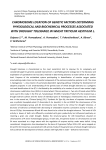Статьи журнала - Журнал стресс-физиологии и биохимии
Все статьи: 984
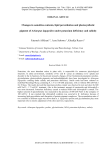
Статья научная
Potassium, the most abundant cation in plant cells, is responsible for numerous physiological functions. In saline environment, similarity of Na+ and K+ causes an unbalance in K+ uptake and disorder in the its functions. In the present research, changes of four biochemical parameters (proline, glycinebetaine, photosynthetic pigments and malondialdehyde) have been investigated in Aeluropus lagopoides seedling under salinity and potassium deficiency. Sterile seeds had been cultured on modified Murashige-Skoog containing 0, 1.75 or 100 mM potassium, with or without 600 mM NaCl for 30 days. The results showed that maximum proline content was observed in root and shoot by 600 mM NaCl + 1.75 mM K+ treatment. Also in this treatment, amount of carotenoids and chlorophyll a was more decreased. Potassium deficiency caused to reduced MDA and chlorophyll b content. The highest amount of glycinebetaine was measured in the presence of 600 mM NaCl in the company of 100 mM K+. It can conclude that chlorophyll oxidation was occurred in K+ deficiency because of increasing lipid peroxidation and disruption of protein-pigment complexes. The accumulation rates of two osmolite in different organ was shown that in A. lagopoides proline and glycinebetaine play more important role in osmotic adjustment of the shoot and root, respectively.
Бесплатно
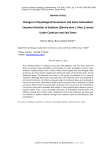
Статья научная
The combined effect of cadmium stress (0,5 mM Cd(NO3)2) and salt stress (100 mM NaCl) on growth, lipid peroxidation and activities of some antioxidant enzymes were studied in soybean (Glycine max L. Merr.) leaves. Shoot lenghts were not changed under all groups. But fresh and dry weight were decreased under salt treatment alone and Cd treatment alone. The decrease was more in the group of combined of Cd and salt treatment. Although APX activity increased under salt treatment alone and combined of Cd and salt treatment, GR activity increased under Cd treatment alone and combined of Cd and salt treatment. Nevertheless DHAR activity increased only in combined of Cd and salt stress. MDA content increased under all groups but it was more in the combined of Cd and salt stress which indicates that salinity is more harmful with cadmium stress in soybean plants. Thus, it was concluded that some of antioxidant enzymes (APX, GR, DHAR) increased their activity under combined of Cd and salt treatment but they were not efficient to protect oxidative damage from soybean plants by alleviating the lipid peroxidation.
Бесплатно
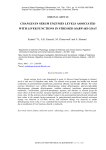
Changes in serum enzymes levels associated with liver functions in stressed Marwari goat
Статья научная
Serum enzyme levels were determined in goats of Marwari breed belonging to farmers' stock of arid tract of Rajasthan state, India. The animals were grouped into healthy and stressed comprising of gastrointestinal parasiticised, pneumonia affected, and drought affected. The serum enzymes determined were sorbitol dehydrogenase, malate dehydrogenase, glucose-6-phosphate dehydrogenase, glutamate dehydrogenase, ornithine carbamoyl transferase, gamma-glutamayl transferase, 5'nucleotidase, glucose-6-phosphatase, arginase, and aldolase. In stressed group the mean values of all the enzymes increased significantly (p≤0.05) as compared to respective healthy mean value. All the enzymes showed highest values in the gastrointestinal parasiticised animals and least values in the animals having pneumonia. In gastrointestinal parasiticised animals maximum change was observed in G-6-Pase activity and minimum change was observed in malate dehydrogenase mean value. It was concluded that Increased activity of all the serum enzymes was due to modulation of liver functions directly or indirectly.
Бесплатно
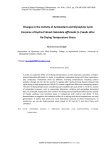
Статья научная
In order to study the effect of re-drying temperatures on the enzymatic activation of hydro-primed Calendula officinalis (L.) seeds, a completely randomized design with three replications was conducted. Treatments were six different re-drying temperatures including control (without drying), 20, 30, 40, 50, and 60 ◦C applied after hydro-priming. Results showed that rapid drying at high temperatures (40-60 ◦C) caused a significant difference comparing control. The best re-drying temperature considering many studied traits was 20-30 ◦C. At 60 ◦C, activity of antioxidant enzymes such as superoxide dismutase, catalase and peroxidase decreased 65.5, 75, and 62%, respectively over control. Re-drying had not significant effect on the activity of malate synthase and isocitrate lyase in comparison with control and 20-30 ◦C that demonstrates no negative and reductive effect of re-drying with these temperatures on seed germination. It seems that seeds are more desiccation tolerant at these temperatures. In conclusion, we can dry hydro-primed seeds slowly at 20 and 30 ◦C and store them until utilization.
Бесплатно
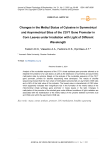
Статья научная
Analysis of the nucleotide sequence of the CSY1 citrate synthase gene promoter allowed us to establish the presence of a CpG island, as well as the distribution of symmetric and asymmetric methylation sites by cytosine. Based on the analysis of the nucleotide sequence of the CSY1 gene promoter, primers for bisulfite sequencing were developed. The results of bisulfite sequencing showed that the main share of methylated cytosines falls on asymmetric CNN sites and is 56% of the total value of this indicator. The lowest value is characteristic of CNG sites, which apparently indicates their insignificant role in the formation of the methyl status of the mitochondrial citrate synthase gene promoter in maize leaves in the light. Changes in methylation of the promoter of the studied gene under different conditions of light irradiation are associated with the redistribution of the methyl status of the cytosine between symmetric (CG and CNG) and within the asymmetric CNN site.
Бесплатно
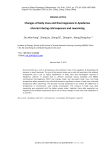
Changes of body mass and thermogenesis in Apodemus chevrieri during cold exposure and rewarming
Статья научная
Environmental cues, such as temperature, play important roles in the regulation of physiology and behavior in small mammals. The aim of the present study was to test the hypothesis that ambient temperature was a cue to induce adjustments in body mass and thermogenic capacity in Apodemus chevrieri. It showed that A. chevrieri increased resting metabolic rate (RMR), nonshivering thermogenesis (NST) and energy intake and decreased body mass and body temperature when exposed to the cold while showed a significant increase in body mass and body temperature after rewarming. The decrease of body temperature can reduce the difference in temperature in environment, save energy consumption. The increase in body mass after rewarming was associated with the higher energy intake. Together, these data supported our hypothesis that ambient temperature was a cue to induce changes in body mass and metabolism in A. chevrieri.
Бесплатно
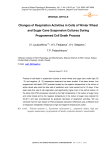
Статья научная
Process of cell death in suspension cultures of winter wheat and sugar cane under high (50 °С) and negative (-8 °С) temperature treatment has been studied. It has been shown, that programmed cell death (PCD) process caused by the negative temperature in the culture of winter wheat was noted for slow rate of realization and it was carried out for 10 days. It has been state that rate of cell respiration was significantly higher than in the control culture. At the same time PCD processes induced by the high temperature in the culture of sugar cane and winter wheat and by the negative temperature in the culture of sugar cane realized for 24-48 h and was accompanied by graduate decrease of respiration activities. We can conclude that the main reason of PCD processes realization differences was a different level of respiration metabolism resistance to high and negative temperatures action.
Бесплатно

Characterization of Medicago arborea L. response to water and salt stress
Статья научная
Medicago arborea L. is a Mediterranean leguminous fodder shrub, regarded as a promising species in arid and semi-arid lands where it can play an important role in the elaboration of a durable pastoral system. The aim of this paper is to investigate and characterize the response of M. arborea plants to water and salt stress at the early growth stage. Seedlings of the species derived from seeds collected in the Djelfa province, Algeria, were grown in pots under greenhouse conditions and separately submitted to water stress, restoring 20%,40%,60%,80% and 100% of substrate field capacity, and salt stress, supplying irrigation water with 0, 50, 100, 150 and 200 meql-1 of NaCl+CaCl2. Stress effects were determined on fresh and dry-matter biomass, relative water content, leaf pigment content (chlorophyll and carotenoids), proline and total soluble sugars amount. Results showed that both water and salt stress affected seedlings growth. In particular, the lowest water regime (20% of field capacity) significantly reduced fresh and dry-biomass and relative water content, whereas seedlings under salinity maintained a good water content (>70%).Chlorophyll a and b , and carotenoids content did not show significant differences among treatments, while proline and total soluble sugars amounts, major osmolytes involved in osmotic adjustment, significantly increased according to salt and water stress intensity...
Бесплатно
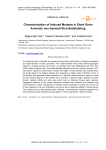
Characterization of induced mutants in short grain aromatic non-basmati rice Badshabhog
Статья научная
An experiment was conducted to evaluate the agronomic performance of advance generation 28 mutant families in the M4 generation. The mutant families were derived following pedigree method by treating aromatic short grain non-basmati land race Badshabhog with 200, 300, 400Gy doses of gamma rays. The mutant families retained the aroma of mother and were 10-15 days earlier. Agronomic performance reveals that height of many families was reduced which will render plants to be lodging resistant and responsive to higher doses of fertilizer. Some of the families have desirable mutant characters viz. flag leaf, panicle exsertion, panicle number and test weight. Majority of the families have reduction in panicle length, spikelet and grain number, spikelet fertility and grain yield which may be improved through gene cleaning. Segregation patterns of the mutant characters indicated that mutations are recessive and micromutations in nature. Appearance of multiple mutant characters in a plant may not be due to true mutations for all such characters, but may be due to pleiotropic effects of mutant genes. The mutants may be used directly and/or indirectly in recombination breeding programme for their beneficial mutant characters through Mutant × Parent and Mutant × Mutant crosses.
Бесплатно
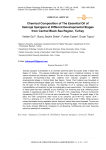
Статья научная
Satureja spicigera (Lamiaceae) is an aromatic perennial plant and grows wildly in Black Sea Region of Turkey. This species traditionally has been used in traditional medicine, to treat various ailments and infectious diseases. The aim of this study was to compare the chemical composition the essential oil that was obtained from Satureja spicigera in different developmental stages in Central Black Sea Region, Turkey. Plant material was harvested at three different phenological stages (pre- flowering, full- flowering and post- flowering period) of the life span of the Satureja spicigera . The essential oil of S. spicigera was obtained by hydrodistillation and analyzed by gas chromatography-mass spectrometry. The hydrodistillation of aerial plant that were collected at pre- flowering, full- flowering and post- flowering period resulted in essential oil yields of 0.64%, 1.17% and 0.12%, respectively. Thirty-six compounds representing 90.83-97.81% of the oils were characterized. Throughout the growth stage of the plant, the main components were found to be carvacrol (32.77-49.11%), thymol (3.04 - 13.21%), γ-terpinene (3.11-13.33%) and ısothymol methyl ether (3.65-11.98%). While carvacrol content decreased during vegetation period, isothymol methyl ether level increased. Thymol and γ-terpinene reached that its highest values during full-flowering stage. The results obtained from this study showed differences compared to pre-flowering, full-flowering and post- flowering period on essential oil composition.
Бесплатно

Статья научная
Background: Invasive alien species (IAS) are broadly distributed all over the world by disturbing or reducing the growth and development of native vegetation. Lantana camara is basically a noxious weed and have a potential to invade a region's indigenous vegetation. Even after knowing all its harmful effects, there has been a little research on various mechanisms followed by this plant to harm the plant species. Results: Random sampling was performed to take plant samples without any bias, to study various mechanisms carried out in plant species. Chemical fingerprinting of samples were then performed in various abiotic stress conditions (cold and hot) to study changes in L. camara under these stressful conditions in order to find the reason behind the invasiveness of this plant species. Stress indicator like malondialdehyde (MDA)/lipid peroxidation was also performed and increased lipid peroxidation during both extremities showed that plant is experiencing oxidative stress...
Бесплатно
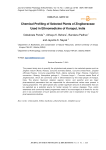
Chemical profiling of selected plants of Zingiberaceae used in Ethnomedicine of Koraput, India
Статья научная
The present study aims to quantify the phytochemicals present in ten selected species such as Zingiber roseum (Roxb.) Roscoe, Curcuma aromatica Salisb., Curcuma amada Roxb., Zingiber officinale Roscoe, Curcuma angustifolia Roxb, Alpinia calcarata (Haw.) Roscoe, Hedychium coronarium J.Koenig, Kaempferia galanga L., Curcuma longa L., Curcuma caesia Roxb of Zingiberaceae , which are commonly used in ethnomedicine by the tribal people of Koraput, India. The phenol, flavonoid, alkaloid, saponin, tannin, and ascorbic acid are major pharmaceutical parameters that are responsible for ethnomedicinal values were present in varying proportions. The plant species also contain significant amount of antioxidants that can be exploited as a potential source for herbal remedy for various diseases. Thus, public awareness and community-based programmes need to be encouraged at all levels for ex situ and in situ conservation of such species and will further use in exploration of new drugs for pharmaceutical industries.
Бесплатно
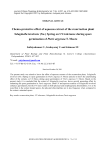
Статья научная
The present study was aimed to know the effect of aqueous extracts of the resurrection plant, Selaginella involvens(Sw.) Spring on spore germination in Pteris argyraeaT. Moore and also to know the ameliorating effect of the extracts on UV-Stress during spore germination of Pteris argyraeaT. Moore. Based on the present study it is concluded that the extract of Selaginella involvens, shows growth promoting effect by enhancing the spore germination in Pteris argyraea.Both UV and aqueous extracts of Selaginella involvensenhances germination, but the UV stress results in both physical and morphogenetic abnormalities. It is to be noted that in the extract treated spores, the physical abnormalities are in less frequency when compared to the extract- untreated spores.
Бесплатно
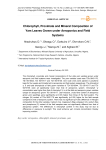
Статья научная
The chlorophyll, proximate and mineral compositions of four elite yam varieties grown under aeroponic and field systems were investigated. The yam varieties used were TDa 98/01176, TDr 95/18544, TDr 95/19177 and TDr 95/19158. One node vines were planted in polythene bags for four weeks and transferred to aeroponics and field system respectively. The chlorophyll a, b and total chlorophylls of field grown varieties of TDr 95/18544, TDr 95/19177 and TDr 95/19158 were all significantly lower than that of aeroponics system. Chlorophyll ‘a’ concentration was higher than that of chlorophyll ‘b’ in all the field and aeroponic grown varieties except for aeroponics grown TDr 95/19177. Leaf moisture, crude fibre content of aeroponics grown yam seedlings were significantly (p˂0.05) higher than those of the field system. The nitrogen (N) content of TDa 98/01176 was significantly (p˂0.05) higher for the field sample compared to that of aeroponic system. There was no significant (p˃0.05) difference in Nitrogen composition for the other varieties. Calcium (Ca), magnesium (Mg), potassium (K), sodium (Na) and phosphorus (P) content of the field samples were not significantly different from that of aeroponics system. The differences in chlorophyll content in this study may be due to differences in exposure to sunlight. This could enhance yam mineral concentration thereby improving nutrition.
Бесплатно
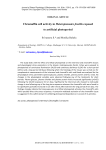
Chromaffin cell activity in Heteropneustes fossilis exposed to artificial photoperiod
Статья научная
The study deals with the effect of artificial photoperiod on the interrenal and chromaffin tissues and physiological stress parameters in the teleost, Heteropneustes fossilis. Fishes were exposed to photoperiods of continuous illumination 24L:0D and continuous darkness 0L:24D for a short period (24hrs) and a long period (10 days) following which the histology of the tissues was carried out for morphometric measurements of the interrenal and chromaffin cells and blood was analyzed for the physiological stress parameters (plasma glucose, plasma chloride, plasma protein and N:L ratio). No changes in the physiological variables were observed following any of the treatments for short periods. Plasma glucose, plasma chloride and plasma protein levels increased significantly (p
Бесплатно
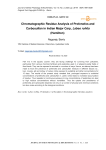
Статья научная
Fish live in the aquatic column; they are facing challenge for surviving from pollutants, particularly from various chemical fertilizers and pesticides used in or adjacent paddy fields or flood lands. They can be exposed to animals in a number of ways. Hence, an attempt has been made to know the presence of profenofos and carbosulfan residues in different tissues viz., liver, muscle, gill and kidney of Labeo rohita exposed to sublethal and lethal concentrations for 15 days. The results of the present study revealed that, prolonged exposure to sublethal concentrations of profenofos and carbosulfan in Labeo rohita leads to increased accumulation of residue. Thus repeated or continuous exposure to low concentrations of pesticides can lead to high residue concentrations without mortalities. Thus the uptake and persistence of profenofos and carbosulfan depends not only on a number of physical and chemical conditions but also varies according to the biological conditions.
Бесплатно

Статья научная
Background: Heavy metal-induced pollution of water bodies has emerged out as a major environmental menace for the modern world in the twenty first century. Many industrial waste waters contain heavy metals including Chromium, which plays a major role in polluting our water and agricultural sustainability in the long run. Due to heavy anthropogenic manoeuvres chromium is released as a waste product from various industries such as electroplating, battery and smelters, leather tanning, textile printing etc. The compounds of Chromium have been known to be strong carcinogens and mutagens that can reach the target organs of human through drinking water and agricultural crops. Chromium is often admixed with industrial effluents that are used for irrigation. Purpose: The uptake of excess concentrations of heavy metals through this effluent irrigation adversely affects plant growth and development. The alternation in plant growth is correlated with the disruption of the physiological disturbances and genotoxicity in plant cell. Results: After the exposure to chromium at five concentrations (12.5, 10, 7.5, 5, and 2.5 mM) respectively the seed germination was adversely affected along with root length inhibition. At higher doses (5 mM onwards) chromium exhibited nucleolar disintegration (by AgNOR protein leaching). In germinating root tip cells above suboptimal concentration (2.5 mM) chromium stands out as potential Phyto-genotoxicant with other toxic effects i.e., lipid peroxidation, electrolyte leakage due to membrane disruption, ROS generation (histological staining of hydroxyl and superoxide radical generation) root cell apoptosis (by Evans blue staining) and disruption of root metabolic activity by inhibition of dehydrogenase activity (by 2,3,5-Triphenyl tetrazolium chloride (TTC) staining methods). Conclusion: These observations constitute a warning signal about the risks of the widespread and increasing presence of chromium into environment especially in agricultural point of view which demands a high throughput evaluation of chromium for its effects on other organisms, even on human health, due to large use of chromium compounds in different gadgets. Lathyrus sativus L. is an excellent model plant for the study of environmental ecotoxicology of different genotoxicants. Implication: Regulatory monitoring and assessment of plant health is necessary for the better understanding of mechanism of action of chromium and to reduce Cr contamination through seeds and the resultant vital genome loss is cash crops.
Бесплатно

Статья научная
A mutation technique provides good exciting opportunities for modern plant breeding. Induced autotetraploidy has potential for genetic improvement of various crops species. The crops like Sunnhemp (2n=16) and Dhaincha (2n=24) are to diploid species, which are included in family legumunaceae and commonly cultivated as green manure in all over the India. The M1 generation in the Sunnhemp and Dhaincha shows mitotic chimera changes due to colchicines treatment. Colchicines induced chimeric mutant showed variation in thickness and colour of leaves due to partitioning of diploid and tetraploid cells into different patches in early growth of plants but later on some days gradually normal conditions were restored in these plants. Mitosis in the chimeric mutants of both plants was highly irregular and resulting a mixoploid composition. The experimental study was done by using the root tips of M1 generation seeds as well as pollen sterility and stomatal Index of both the plants.
Бесплатно
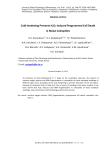
Cold hardening prevents H 2O 2-induced programmed cell death in maize coleoptiles
Статья научная
An influence of cold hardening (8 °С, 7 days) on the respiration intensity, the content of reactive oxygen species and DNA fragmentation in coleoptiles of maize etiolated seedlings of different ages and a possibility of the cold hardening to prevent execution of the cell death, induced by treatment with 10 mM H 2O 2 (for 4 hours) of seedlings have been studied. It has been shown that H 2O 2 induces total DNA fragmentation in coleoptiles of maize etiolated seedlings, and a preliminary cold hardening prevents this process.
Бесплатно

